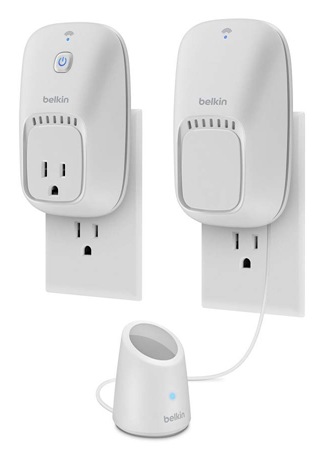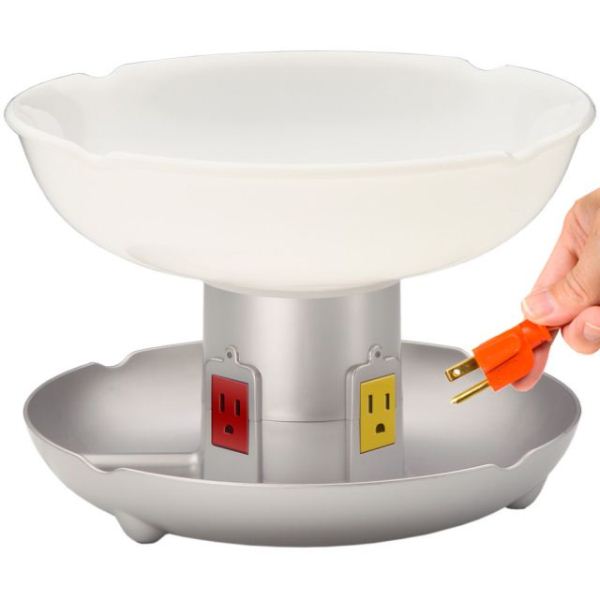Home Automation and the 'Internet of Things'
by Ganesh T S on October 4, 2012 10:30 AM EST- Posted in
- Gadgets
- Home Automation
- Wi-Fi
Power switching is a simple home automation application in which a device can be powered up or down at the socket level remotely. Simple Wi-Fi switches such as the NetRC1 have been around since early 2010. One of the first mainstream companies to enter into this space was Belkin. In this section, we will take a look at two interesting Wi-Fi based power switches, the Belkin WeMo kits and Visible Energy’s offerings.
Belkin WeMo
Belkin’s WeMo lineup consists of two offerings, the plain WeMo Wi-Fi controlled switch ($50) and the WeMo switch combined with a motion sensor ($100). Currently, only an iOS app is available for controlling the switch.

A web-service called ‘If This Then That’ works with these switches and allows bidirectional reaction to events. For example, a event triggering the motion sensor on a particular unit could be used to generate an email message. Similarly, an event happening on a website (say, a weather channel website indicating that the sun has set at a particular location) can trigger a particular switch on.
Currently, the device seems to be recommendable only to consumers in the Apple ecosystem because of the absence of an Android app. It is not clear whether the unit is accessible from a browser on the local network in the case that there is no access to the Internet and an iOS device is not available. Similar to the walled garden being created by Nest, Belkin also refuses to document the APIs officially. However, this has not prevented the communication methods from getting exposed. The concerns that I voiced in the earlier section regarding Nest warrant a repetition here too. Belkin does plan to add more Wi-Fi enabled home automation devices such as door locks and light bulbs to this lineup. That is a positive compared to having a dedicated app with a different UI for the thermostat alone. In any case, home automation system adopters should try to ensure that the components being put in have well-documented control interfaces.
Visible Energy
My search for an economical and open Wi-Fi power switch ended when I spotted Visible Energy’s UFO Power Center and Monostrip. In addition to the ability to power the outlets up and down over Wi-Fi, they also provide real time power usage feedback. Like the WeMo, only an iOS app is available right now. However, web access is also provided using the Visible Energy Web Dashboard. The four-outlet UFO Power Center comes in at $130, while the two-socket Monostrip comes in at $49. Visible Energy also sells a version of the Monostrip with temperature and humidity sensors at $130.
The UFO power center has a strange industrial design, while the Monostrip is a little more conventional in nature. While we are looking at the two units from a Home Automation perspective, the company stresses the fact that the products are more about conserving electricity and creating a user friendly energy management system.
The energy management goals make it necessary for the product to have real time power monitoring. This is a very useful feature (actually, the primary feature) present in Visible Energy’s products when compared to other Wi-Fi enabled power switches. Power consumption is calculated and refreshed every second. Energy usage is calculated 50 times a second and the data is recorded at 5 minute intervals.
The real clincher is the availability of extensive developer documentation for accessing the energy / power data and controlling the units. This makes it easy for third parties to create custom interfaces in a home automation setting.












54 Comments
View All Comments
southpaw42_i - Thursday, October 4, 2012 - link
Electric IMP looks to become big Home automation over next few years.Product developer will be able to add HA WIFI features to their products without the needed support cost of a managing the connection and the service themselves or the FCC validation of each product..
http://electricimp.com/
ganeshts - Thursday, October 4, 2012 - link
Looks like a very interesting product. I will be sure to investigate.jamyryals - Thursday, October 4, 2012 - link
Thanks for the article Ganesh, very interesting and I agree that this technology is starting to get more accessible. However, I must disagree with the statement that it's not possible to recommend products that do not have a documented API. Nest works great for me standalone. Why would the average customer need to connect it to anything else? My sprinkler system is automated as well. It won't turn on if it has rained. The automated door locks will open when I approach with my cell phones. I think the simplicity and predictability in how these devices operate is key for mass consumer adoption.I am a developer so there's nothing technologically in this realm that has stopped me from automating my house in the past. It's practical matters; cost and me becoming on call support in my own house. Anytime the lights don't come on the way they are expected to I'll have to go troubleshoot my devices/scripts.
If we had our wish we would get both simplicity and ultimate control. That's just not the way the consumer behaves though. Consumers will avoid poorly designed products that tout open APIs as a major selling point. People want things that work and they can understand.
ganeshts - Thursday, October 4, 2012 - link
I don't disagree with you on the point that Nest is a great device. If it were not, it wouldn't have achieved this much success.Products such as Radio Thermostat CT-30 and those from Visible Energy barely make a mention of open APIs in their marketing material. So, it is not that they 'tout it as a major selling point'. My intention, as a tech journalist, is to point out where products can improve. In that respect, I am a cynical customer for most of these companies.
To take the computing analogue, many users are satisfied with the Apple ecosystem, but there are a number of users out there who stand by Android for its open nature. Some journalists recommend and stand by Apple's products, while others are on the Android side of things. Both of them have a place in the market. Similarly, devices such as Nest will be popular in the market for some time to come because 'they just work' and people are enamoured by the appearance and usability. Just as Android continues to grow, devices which open up for ultimate control will give consumers better choices (particularly for the tech audience that makes up a majority of AT's readers).
Publications like Engadget, Gizmodo, Verge, AllThingsD (WSJ) provide lots of attention to products like the Nest. As a tech journalist for AT, I consider it my job done if consumers are at least made aware of the other more flexible options available.
bobbozzo - Friday, October 5, 2012 - link
"Nest works great for me standalone. Why would the average customer need to connect it to anything else?"I'd like to have my house open the windows and turn off the A/C when the temperature drops in the evening, and I'd prefer to do it with one application. I can program, but I'd rather have something available off-the-shelf.
shalomo1 - Sunday, October 21, 2012 - link
I am currently working on a project about home automation, I would like to meet and share ideas with you. this is my mail abraham.o@aol.com. ThanksCSMR - Thursday, October 4, 2012 - link
Good to have an article on this.Unfortunate that if there's a conclusion, it's that WiFi will become a suitable technology in 2015 with 802.11ah.
Very little is even known about 802.11ah. It's too early to say what it is, let alone whether it will take over low power networking.
I agree that: in the future, a low power wireless networking standard suitable for home automation will be standardized by IEEE and be called 802.11something.
Maybe there will be so many connected low-power devices that the new standard will be integrated into many wireless access points and routers.
What is unfortunate is that it will take years for this to happen.
ganeshts - Thursday, October 4, 2012 - link
Hmm.. low power Wi-Fi is only needed in a subset of HA devices. As I pointed out in the piece, there are already plenty of Wi-Fi based HA products and silicon vendors are providing low power platforms even with current Wi-Fi technology.noblemo - Thursday, October 4, 2012 - link
Bluetooth 4.0 Low Energy (BLE) is another protocol worth mentioning. It is a low-bandwidth, low-power technology that enables users to communicate directly to a device using a smartphone or tablet without the need for a separate controller or network connection. A self-contained sensor pod including a BLE module and battery can fit within a package about the size of a stack of six or seven 25-cent coins.In a pre-802.11ah world, Wi-Fi is better suited to high bandwidth or web-enabled devices with external power. In practice, I expect to see hybrid solutions using Wi-Fi and a second technology for remote, low power devices.
Chapbass - Thursday, October 4, 2012 - link
Hey, just wanted to take a moment to recognize Ganesh for his work. I know a lot of people are on the mobile device bandwagon and all of that, but I consistently find Ganesh's work to be unique, informative, and incredibly refreshing to this site.Keep it up, love reading it!